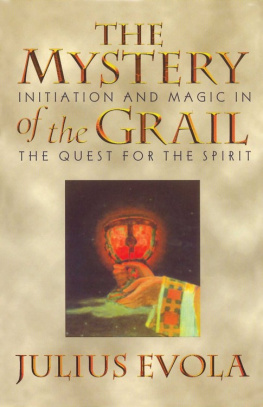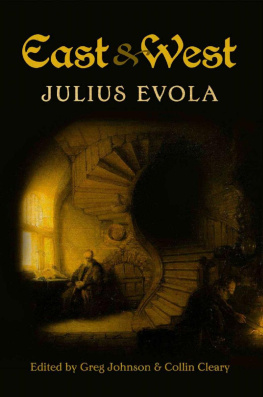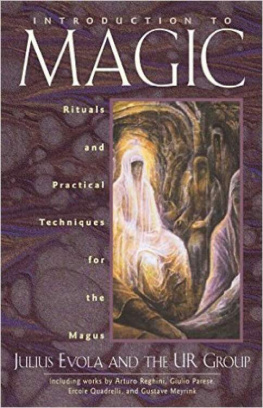Julius Evola et al. - Introduction to Magic
Here you can read online Julius Evola et al. - Introduction to Magic full text of the book (entire story) in english for free. Download pdf and epub, get meaning, cover and reviews about this ebook. year: 2018, publisher: Inner Traditions, genre: Science fiction / Religion. Description of the work, (preface) as well as reviews are available. Best literature library LitArk.com created for fans of good reading and offers a wide selection of genres:
Romance novel
Science fiction
Adventure
Detective
Science
History
Home and family
Prose
Art
Politics
Computer
Non-fiction
Religion
Business
Children
Humor
Choose a favorite category and find really read worthwhile books. Enjoy immersion in the world of imagination, feel the emotions of the characters or learn something new for yourself, make an fascinating discovery.
- Book:Introduction to Magic
- Author:
- Publisher:Inner Traditions
- Genre:
- Year:2018
- Rating:4 / 5
- Favourites:Add to favourites
- Your mark:
Introduction to Magic: summary, description and annotation
We offer to read an annotation, description, summary or preface (depends on what the author of the book "Introduction to Magic" wrote himself). If you haven't found the necessary information about the book — write in the comments, we will try to find it.
Shares a rigorous selection of initiatory exercises, including instructions for creating the diaphanous body of theOpus magicum, establishing initiatic consciousness after death, and the construction of magical chains (the enchained awareness of initiates)
Offers studies of mystery traditions throughout history, presenting not only the principles themselves but also witnesses to them and their continual validity today
The Gruppo di UR was a group of Italian esotericists who collaborated from 1927 to 1929. The purpose of this group was to study and practice ancient rituals gleaned from the mystery traditions of the world, both East and West, in order to attain a state of superhuman consciousness and power to allow them to act magically on the world. They produced a monthly journal containing techniques for spiritual realization, accounts of personal experiences, translations of ancient texts, and original essays on esoteric topics. The group included a distinguished line-up of occultists, neo-pagans, freemasons, Anthroposophists, orientalists, poets, and members of high society. The prime movers of the group were Arturo Reghini (1878-1946), a Pythagorean mathematician and reviver of a spiritual Freemasonry, and Julius Evola (1898-1974), then a young philosopher with a precocious mastery of the esoteric doctrines of East and West. Many years later, in 1971, Evola gathered these essays into three volumes. Inner Traditions published Volume I in 2001, under the titleIntroduction to Magic: Rituals and Practical Techniques for the Magus.
This volume, the second in the series, complements the first one, yet they are not strictly sequential, and their contents can be read in any order. Volume II shares authentic initiatic wisdom and a rigorous selection of initiatory exercises, including instructions for creating the diaphanous body of theOpus magicum, establishing initiatic consciousness after death, and the construction of magical chains (the enchained awareness of initiates). It offers studies of mystery traditions throughout history, presenting not only the principles themselves but also witnesses to them and their continual validity today.
This series shows that the Magic of the UR Group meant an active and affirmative attitude toward individual development, handed down from a primordial tradition and discernable in alchemy, Hermetism, esoteric religious doctrines, indigenous practices, Tantra, Taoism, Buddhism, Vedanta, and the pagan mysteries of the West. Although some of the practical experiments demanded extraordinary efforts, both individual and collective, there is incalculable value here even for the less heroic, for merely reading these essays leaves a permanent mark on the reader.
Julius Evola et al.: author's other books
Who wrote Introduction to Magic? Find out the surname, the name of the author of the book and a list of all author's works by series.









